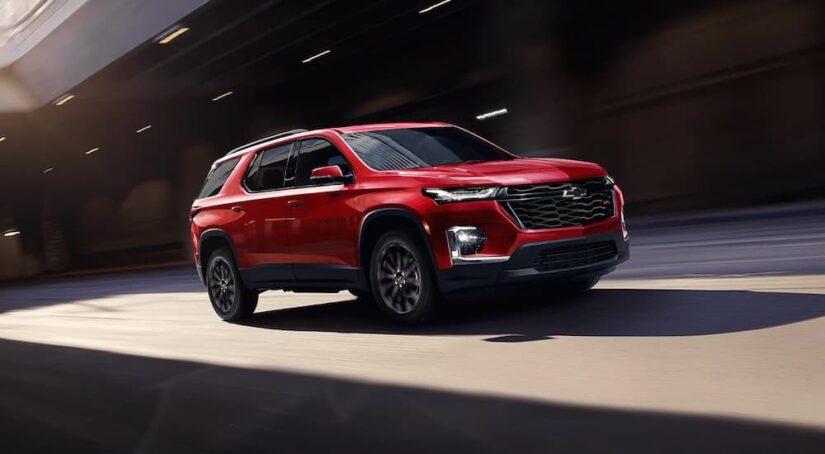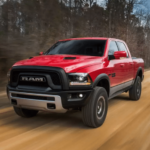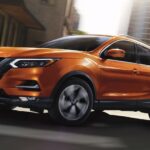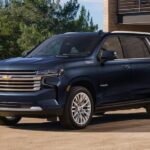The three-row SUV has supplanted the minivan as the go-to choice for those seeking to maximize seating and cargo capacity. With their improved utility, ride height, and performance, these three-row models provide a unique list of attributes that make them the ideal family vehicle. From carpooling and cargo hauling to road trips and everyday errands, three-row SUVs put the utility in sports utility vehicle. SUVs have proven popular since their debut in the mid-1980s, but sales have been on a particular upswing as of late, with SUVs now accounting for 46 percent of all new vehicle sales. This popularity is good news for consumers when it comes to the price and availability of used models, though the sheer number of choices can often be a little overwhelming.
Any driver comparing used SUVs for sale will notice that unibody-based crossover models have grabbed all the headlines as of late, but traditional body-on-frame models still have a place in today’s market. Just look at the Chevy Tahoe, which, in addition to providing ample seating for up to nine passengers, also offers up to 8,600 lbs of towing. The Tahoe’s smaller cousin, the Chevy Traverse, might not be able to match that number, but it does regularly lead its class in interior cargo space. These two Chevy models clearly stand out when it comes to used three-row models, but they’re not the only SUVs that are worth a closer look. Read on as we take a closer look at three of our favorite used three-row SUVs, see how they’ve evolved over the years, and figure out which models are worth a test drive.
#1 – Chevy Traverse (2018-2023)
The Chevy Traverse defies its midsize designation to provide drivers with one of the roomiest and most comfortable three-row SUVs in its class. Chevy made some important updates going into the Traverse’s second generation in 2018, yet somehow managed to shed 350 lbs without a noticeable impact on utility. Chevy updated the Traverse’s exterior for 2022, revising the SUV’s style to more closely resemble models like the Suburban and Tahoe. The addition of thin LED headlights and taillights gives the Traverse a more contemporary look, though any second-gen model is a notable improvement over the comparatively passé first-gen version.
Styling aside, it’s the Traverse’s roomy cabin that’s the highlight. The second-gen Traverse offers drivers a spacious interior with over 58 cu.ft. of cargo space with the third row folded and as much as 98.2 cu.ft. when both the second and third rows are stowed away. Those numbers are good enough for the Traverse to lead its class in terms of cargo space. With so much easily accessible cargo space on offer, drivers won’t have to make any hard decisions about what to bring along for the ride, upping the Traverse’s practicality and making it the go-to choice for families seeking their next daily driver.
Speaking of families, the Traverse provides more than enough room for the average household and can accommodate up to eight passengers. That number drops to seven when the Traverse is optioned with the available second-row captain’s chairs, but the loss of that one seat could be well worth the sacrifice if it gives families the ability to separate quarreling kids. The roomy Traverse will also provide ample space for any adults who might find themselves in the backseat, with 38.4 inches of second-row legroom. The third row is a little tighter at 33.5 inches, but it should still be comfortable for all but the tallest passengers.
If you’re looking for the latest and greatest in-vehicle entertainment and safety tech, you’ll want to narrow down your search to Traverse models produced from 2020 or later. That was the year that Chevy replaced the SUV’s aging MyLink infotainment system with the Infotainment 3 platform, which includes some major upgrades in a few key categories. The automaker placed a new emphasis on safety as it moved into the Traverse’s second generation, adding a clever new Buckle to Drive feature as part of its Teen Driver technology that prevents drivers from engaging the shifter until they’re safely strapped in.
In 2022, Chevy made a long list of previously optional advanced driver assistance systems (ADAS) like automatic emergency braking, forward collision alert, lane keep assist with lane departure warning, and front pedestrian braking part of the standard package. Other features like IntelliBeam auto high beams and a following distance indicator up the SUV’s convenience factor, but if we had to pick the Traverse’s most original safety-related feature, it would easily be the Safety Alert Seat on the Premier and High Country trims. With the ability to detect potential collisions and send vibrating pulses to either side of the driver’s seat, the feature could easily mean the difference between a near miss and a costly accident.
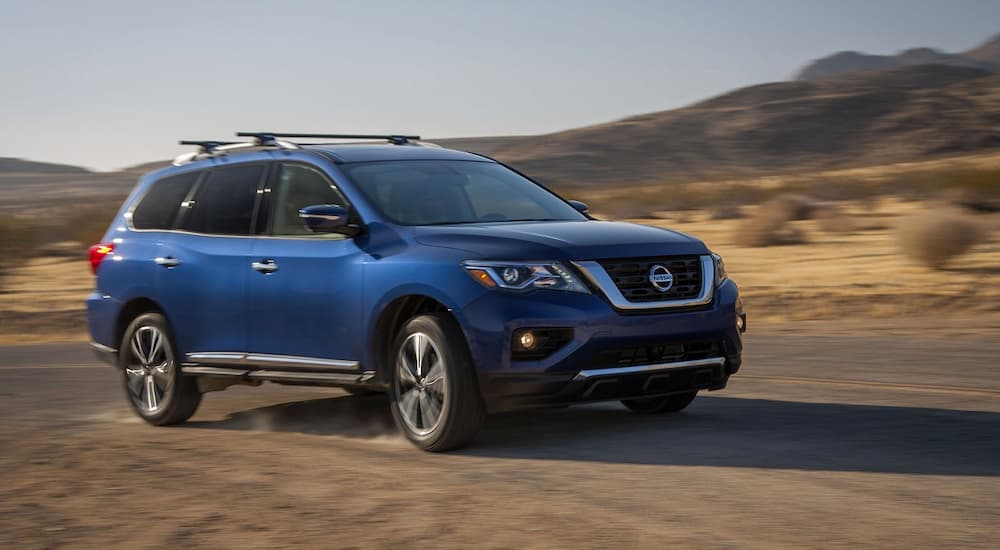
#2 – Nissan Pathfinder (2013-2020)
Nissan made considerable changes when designing the fourth-gen Pathfinder, updating the three-row SUV to capitalize on some important emerging trends. The most notable change would have to be the Pathfinder’s construction. Nissan ditched the body-on-frame approach in 2013, treating the Pathfinder to a unibody makeover to give the old-school SUV a more up-to-date crossover style while also reducing the model’s overall weight by as much as 500 lbs. The redesign went a long way towards improving the Pathfinder’s driving dynamics, creating a tighter, more responsive ride without sacrificing the SUV’s ability to put in a little work.
The fourth-gen Pathfinder boasts a remarkable towing capacity of 6,000 lbs in 2017 and later models, a feat that can be credited to the SUV’s upgraded 3.5-liter V6 that puts out some 284 hp. That’s a 24-horsepower improvement over the 2016 model, which comes courtesy of a new direct injection system that made the 2017 Pathfinder the most powerful version to date. Nissan managed to up the power without sacrificing fuel economy, but the Pathfinder’s upgrades stretched far beyond what can be found under the hood.
The brand also restyled the 2017 Pathfinder’s exterior to give the three-row model an edgier, sportier look that’s a real departure from the rounded, almost minivan-like approach used in previous model years. LED daytime running lights, plus restyled headlights and taillights, help to complete the SUV’s modern look. Added convenience features like a motion-activated liftgate improved the Pathfiner’s practicality for those seeking a reliable family vehicle that puts a premium on accessibility.
The Pathfinder’s 2017 refresh also saw Nissan treat drivers to a new eight-inch touchscreen infotainment display, which serves as the command center for the vehicle’s long list of convenience and entertainment features. This includes hands-free text messaging, Bluetooth connectivity, voice recognition, navigation, and an available 13-speaker Bose audio system. Nissan doubled down on the Pathfinder’s technological arsenal for 2019 with the addition of rear parking sensors, USB-C ports, and a full complement of ADAS features like blind-spot monitoring, rear cross-traffic alert, and adaptive cruise control across more trims. These improvements make a used Nissan Pathfinder a well-rounded three-row model that’s sure to be a hit with any driver seeking a satisfying combination of performance, convenience, and comfort.
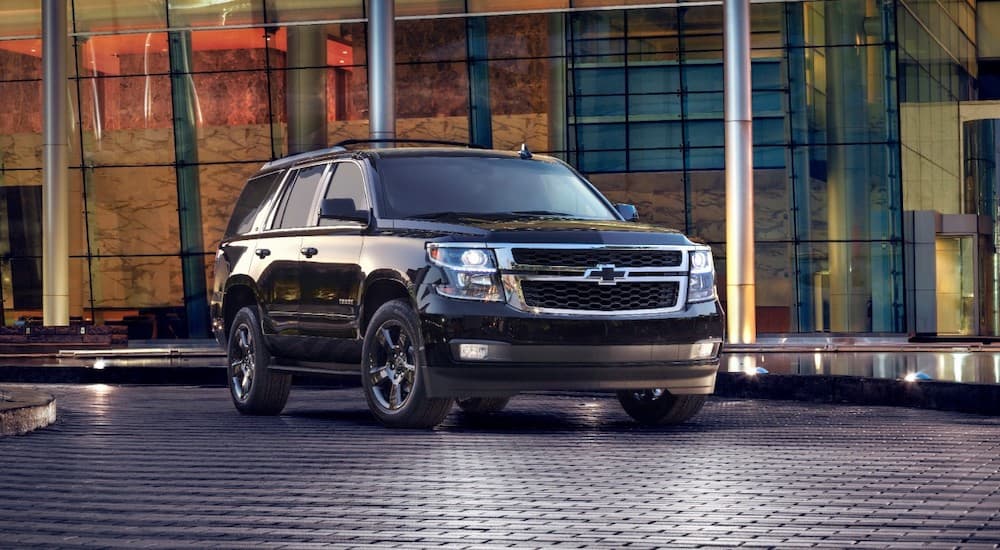
#3 – Chevy Tahoe (2015-2020)
Chevy’s full-size Tahoe might just represent the sweet spot in the brand’s SUV lineup. The Tahoe is smaller than the hulking Suburban, but it still has more than enough cargo room, and its robust body-on-frame construction means it can hang with the big boys when it comes to towing and hauling. The fourth-generation Tahoe, which was introduced in 2015, offers an impressive 8,600 lb towing capacity when equipped with the Max Trailering package. This feat is made possible thanks to the SUV’s boxed frame and use of high-strength steel, which greatly improves the Tahoe’s structural rigidity.
Of course, that sort of heavy-duty construction often comes at a price. Weighing in at around 5,500 lbs, the fourth-gen Tahoe would be uniquely susceptible to every bump in the road if not for the addition of optional magnetorheological shocks. These advanced dampers use a magnetic fluid that can quickly alter its viscosity when exposed to a magnetic field. This approach gives the Tahoe’s dampers the ability to tailor their response to rapidly changing road conditions, providing a smooth, comfortable ride no matter what sort of terrain you might face.
The latter half of the Tahoe’s fourth-generation run includes some important enhancements in the tech and performance departments. The 2017 model saw the addition of the Teen Driver safety monitoring system, a unique feature that provides some valuable peace of mind for parents who are handing over the keys to their kids for the first time. The system comes with the same Buckle to Drive feature found on the Traverse, as well as an in-vehicle report card that logs a long list of pertinent safety-related information, from distance driven to maximum speed, anti-lock brake events, and forward collision alerts.
The 2018 model year saw a significant update to the Tahoe’s performance credentials as Chevy added an optional 6.2-liter EcoTec3 V8 with 420 hp. While initially limited to the sporty RST trim, Chevy made the brawny engine more available in later model years. Paired with a 10-speed automatic transmission, the 6.2-liter engine lets the nearly three-ton Tahoe speed from zero to 60 mph in just 5.7 seconds––a 1.5-second improvement over the standard Tahoe.
Finding the Right SUV
When you’re on the hunt for a used three-row SUV, it’s important to do a little research. The popularity of this category has led almost every automaker to try their hand at creating a three-row model, but the resulting SUVs really run the gamut when it comes to cargo and passenger space, utility, and reliability. That said, there are some clear standouts that are worth a second look. Chevy’s reputation in the segment stretches back almost 100 years to the Suburban Carryall, an early iteration of the SUV that was notable for being one of the first vehicles to ditch a wooden body for steel construction. That commitment to innovation is reflected in Chevy’s contemporary SUV offerings, with models like the Traverse and Tahoe continuing to set the bar in the ultra-competitive category. The Nissan Pathfinder might be a standout when it comes to towing capacity and exterior styling, but few brands can match Chevy when it comes to crafting a modern three-row SUV.
